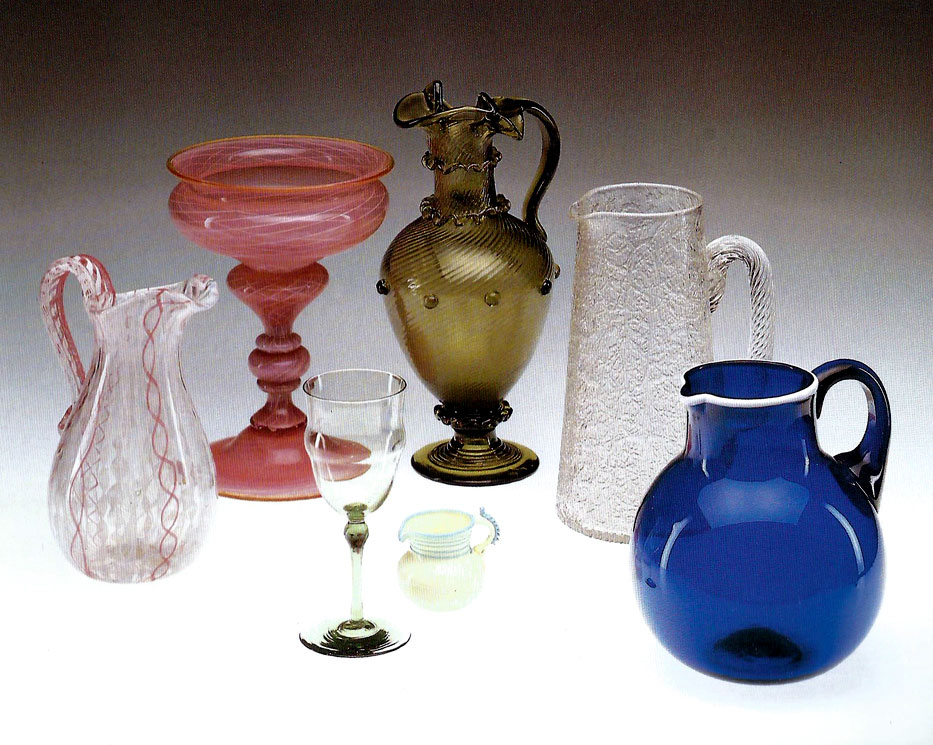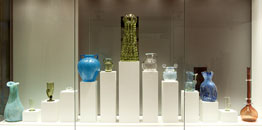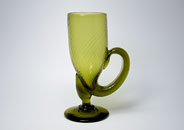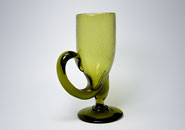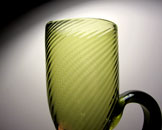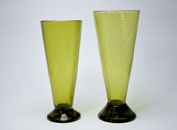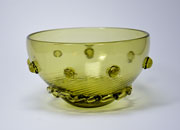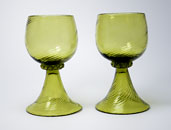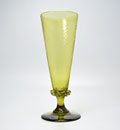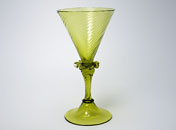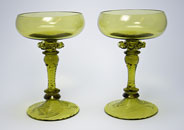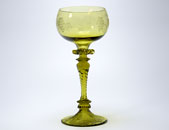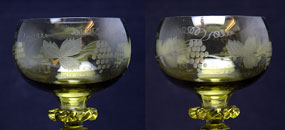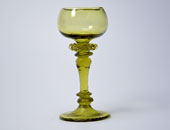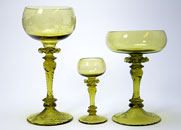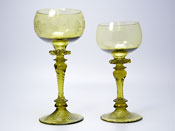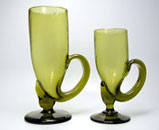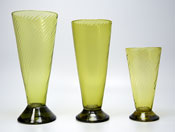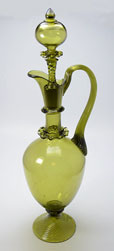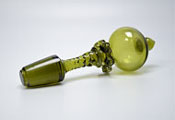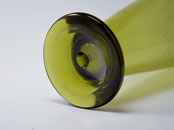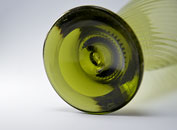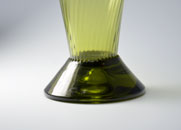Sowerby Green Wrythen Glass ?
This page will introduce further information about a green, wrythen range of glass that was possibly made by the the Sowerby Art Glass Studio.
A picture from the book 'British Glass 1800-1914' by Charles R. Hajdamach. The picture is on page 257 and shows a group of glass from the Dudley glass collection at the Stourbridge Glass Museum.
On page 267 Mr. Hajdamach refers to the three pieces of Sowerby glass shown in this picture. The green jug is captioned, 'possibly from the Sowerby art glass range'.
Writing about Sowerby Venetian-style glass and referring to the jug he says, '.. more fanciful ware was also made with a variety of decorative techniques which included applied prunts and trailed and pincered collars on to wrythen moulded shapes'.
The first picture above shows a display of Sowerby Art Glass from the Northern Spirit Exhibition at the Laing Art Gallery in Newcastle. The third object from the left is an unusual dark green wrythen mug. More information about the mug is available on the Tyne & Wear Archive and Museums website, item number H6137.
The second and third pictures shows one of these mugs in more detail. The mug, and several other objects, were a bequest to the museum from Mrs R Spence Watson. Mrs R. Spence Watson is probably Elizabeth Spence Watson who died in 1919. Elizabeth was the widow of Robert Spence Watson (1837-1911), who was a close friend of John Sowerby, the father of John George Sowerby. A total of nine pieces of glass were included in the bequest as well as a number of paintings and drawings. Seven of the pieces of glass, including the wrythen mug are in the display from the Northern Spirit Exhibition shown in the first picture.
The mug is made from a dark olive green glass which does not react to UV light. The description of this item on the museum website states: "The rippling surface effect on the glass is known as 'wrythen ribbing' and is a decorative technique seen on a number of forms in this range". This implies that this was not the only item made in this fashion but that there was a range of glass produced. The wrythen lines are very fine giving the bowl a beautiful 'criss-cross' effect when viewed from the side.
The fourth picture shows this fine wrythen effect, this is a feature of all glass in this range, as is the colour and common use of a ground and polished pontil.
Green Wrythen Glass Gallery
Pictures from my collection.
Picture 1: A mug similar to the one exhibited in the Northern Spirit Exhibition at the Laign Art Gallery. The mug is 17.5cm tall and has a ground and polished pontil. The construction is unusual, the base of the wrythen bowl being elongated and drawn up to form a handle, a stem and foot have then been attached.
Picture 2: Two tall, possibly ale, glasses, 16.5cm and 18cm high. Wrythen body and heavy solid foot, both have polished and ground pontils.
Picture 3: Wrythen bowl 12.5cm in diameter. 8 plain spherical prunts, crimped ruffled collar around the bottom of the glass, ground and polished pontil.
Picture 4: Pair of roemers, 12cm tall with wrythen bowls and base. There is a crimped ruffled collar between the bowl and base.
Picture 5: Footed ale glass, 19.5cm tall with crimped ruffled collar.
Picture 6: Wine glass, 15cm tall with wrythen conical bowl and plain base. There is a spiral stem with a crimped ruffled collar between the stem and bowl. There is also a plain ring collar at the bottom stem. I have also seen a small, 9.5cm tall, version of this glass.
Picture 7: Pair of wine or jelly glasses, 13.5cm tall. Bulbous plain bowls 9cm wide with cut and ground rims. Wrythen base and spiral stem with two plain ring collars at the bottom and one at the top with crimped ruffled collar between the top ring collar and the bowl.
Picture 8: Wine glass, 17cm tall. Bulbous plain bowl 8cm wide with cut and ground rim. Bowl is wheel engraved with grapes and vine leaves. Wrythen base and spiral stem with two plain ring collars at the bottom and one at the top with crimped ruffled collar between the top ring collar and the bowl. I have also seen a version of this wine glass where the bowl is engraved with the owners initials, and others with no engraved decoration.
Picture 9: Shows the detail of the engraved grapes and vine on the wine glass in picture 8.
Picture 10: Small 'Liqueur' glass, 9.5cm tall. The same shape as the glass in Picture 8 but much smaller with a 4.5cm wide bowl.
Picture 11: Shows the difference in sizes between the glasses in Pictures 7, 8 and 10.
Picture 12: Shows the glass with vines in picture 8 at 17cm tall and a similar glass of the same shape with no decoration at 15cm tall.
Picture 13: Shows the difference in sizes between the green handled mug in picture 1 on the right at 17.5cm tall and the larger one on the left at 21.5cm tall.
Picture 14: Ale glasses in three sizes, 18cm, 16.5cm and 12.5cm.
Picture 15: Large claret jug with stopper, 41.5cm tall. Wrythen foot, twisted handle with crimped ruffled and blade collars
Picture 16: Stopper from claret jug showing bulbous top and twisted stem with crimped ruffled and blade collars.
Ale Glasses
Picture 1: Ale glasses as pictured above, small and large.
Picture 2: When I bought the smaller ale glass I noticed that, after the pontil had been ground out and polished, a small bevelled hole about 1cm deep had been made in the center of the bottom of the glass. I asked a number of people and no one could work out what it was for.
Picture 3: Later I bought the second, larger glass. This one had the same depth hole with a larger bevel.
Picture 4: Then I worked it out. Looking at the base from the side the bevel is magnified and looks like a large 'indent' in the bottom of the base. This is not so obvious in the smaller glass as the base is not so deep and the bevel is not so large. An unusual and a very clever illusion.
Observations
The green colour of the jug in the Hajdamach picture is darker, the lighting used in the picture may have been different, but it has enough similarities to say it is 'from the same glass range'. All the pieces in the Wrythen Glass Gallery have been photographed using the same lighting and look to be made from the same, or very similar, green glass.
Sowerby's were capable of engraving the grape and vine decoration that is used on one of the glasses. There is an example on page 30 of the 1874 pattern book and several others on pages 75 to 81 of the 1885 pattern book.
The pattern books also show that Sowerby's produced a large number of pressed drinking glasses in the form of mugs and beer glasses but there are very few patterns for wine glasses.
While researching and purchasing this glass I have seen it variously described as Bohemian, Venetian, German, Scottish, James Powell, Villeroy & Boch,
Theresienthal and made at a number of different dates.
The greater number of items I have seen for sale have been here, in the UK, with just a couple in the US and again on the continent.
Considering this, and the similarity of the wrythen decoration,
blade and vermicular collars and green colour, I believe that all these pieces would certainly have originated in the UK and
been made by the same manufacturer.
Given the provenance of the handled mug that manufacturer may well have been Sowerby's in the late 1870's.
Again, I would be interested to hear from anyone who has any of this type of glass or more information about it.

